 W
WHybrid grapes are grape varieties that are the product of a crossing of two or more Vitis species. This is in contrast to crossings between grape varieties of the same species, typically Vitis vinifera, the European grapevine. Hybrid grapes are also referred to as inter-specific crossings or "Modern Varieties." Due to their often excellent tolerance to powdery mildew, other fungal diseases, nematodes, and phylloxera, hybrid varieties have, to some extent, become a renewed focus for European breeding programs. The recently developed varieties, Rondo, and Regent are examples of newer hybrid grape varieties for European viticulturalists. Several North American breeding programs, such as those at Cornell and the University of Minnesota, focus exclusively on hybrid grapes, with active and successful programs, having created hundreds if not thousands of new varieties.
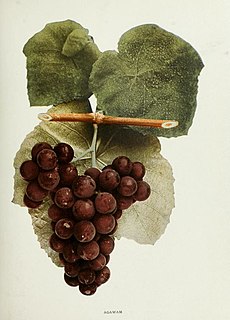 W
WAgawam is a hybrid grape variety. It is a crossing of Carter and Muscat Hamburg. Agawam is one of the so-called Rogers' Hybrids created by E.S. Rogers in the early-to-mid-19th century, and is unique among the named cultivars of that group in that it is self-fertile.
 W
WBaco blanc or Baco 22A is a French-American hybrid grape variety. It is a cross of Folle blanche and the Noah grape, created in 1898 by the grape breeder François Baco. Folle blanche is its Vitis vinifera parent. Noah, its other parent, is itself a cross of Vitis labrusca and Vitis riparia.
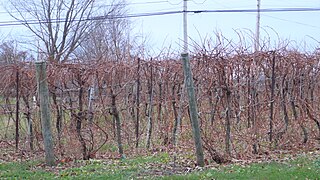 W
WBaco noir is a hybrid red wine grape variety produced by Francois Baco from a cross of Vitis vinifera var. Folle blanche, a French wine grape, and an unknown variety of Vitis riparia indigenous to North America.
 W
WCabernet Cortis is a dark-skinned grape variety used for wine. It was bred in 1982 by Norbert Becker at the viticultural institute in Freiburg, Germany as part of a programme searching for disease-resistant grape varieties. It received German varietal protection in 2003.
 W
WCatawba is a red American grape variety used for wine as well as juice, jams and jellies. The grape can have a pronounced musky or "foxy" flavor. Grown predominantly on the East Coast of the United States, this purplish-red grape is a likely cross of the native American Vitis labrusca and the Vitis vinifera cultivar Semillon. Its exact origins are unclear but it seems to have originated somewhere on the East coast from the Carolinas to Maryland.
 W
WChambourcin is a species of grapevines belonging to the Vitis genus in the flowering plant family Vitaceae. It is a French-American interspecific hybrid grape variety used for making wine. Its parentage is uncertain. The hybrid was produced by Joannes Seyve who often used Seibel hybrids produced in the 1860s. The grape has only been available since 1963; it has a good resistance to fungal disease, and is one of the parents of the new disease resistant variety, Regent, which is increasing in popularity among German grape growers. Chambourcin is considered a very productive grape with crop yields reported ranging from 11.1 tons per hectare to 17.3 tons per hectare in a study performed by Ohio State University.
 W
WClinton is a red variety of hybrid grape. Its phylloxera resistance led to its being planted in small amounts in the eastern Alps, although it imparts a pronounced foxiness and dark red colour to wine made from its juice.
 W
WFrontenac is an interspecific hybrid grapevine that is a result of research and cross-breeding by the University of Minnesota. It was grown from a crossing of the complex interspecific hybrid Landot 4511 and a very cold hardy selection of Vitis riparia. It was released in 1996.
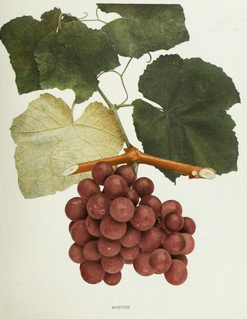 W
WGoethe is one of the collection of grape varieties known as Rogers' Hybrids, created by E.S. Rogers in the mid-19th century, and is the result of a cross of Carter, a selection of Vitis labrusca, and Black Hamburg, a selection of Vitis vinifera. It was originally known as Rogers No. 1, until Rogers named it after Johann Wolfgang Goethe, the German author, artist, and scientist.
 W
WHerbert is one of the collection of grape varieties known as Rogers' Hybrids, created by E.S. Rogers in the mid-19th century, and is the result of a cross of Carter, a selection of Vitis labrusca, and Black Hamburg, a selection of Vitis vinifera. It was originally known as Rogers No. 44.
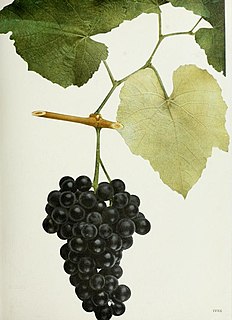 W
WIves noir is a red hybrid grape variety that is grown throughout the United States. Named after its propagator, Connecticut wine grower Henry Ives, the grape's pedigree and exact origin are unclear. After Prohibition in the United States, Ives was a popular grape used in the production of sweet port-style wines but saw its plantings steadily decrease throughout the 20th century as the vine's susceptibility to air pollution took its toll.
 W
WKyoho grapes are a fox grape (Concord-like) cross popular in East Asia. The fruits are blackish-purple, or almost black, with large seeds and juicy flesh with high sugar content and mild acidity. The variety was first produced by a Japanese viniculturist, Yasushi Ohinoue in the 1930s and 1940s, by crossing Ishiharawase and Centennial grape varieties. Like the Concord, Kyoho is a slip-skin variety, meaning that the skin is easily separated from the fruit. The seeds are bitter and the skin is not traditionally eaten. The grape maintains some of the flavor qualities of the Concord, known to consumers from the flavor of most grape jellies and Concord grape juice.
 W
WL'Acadie blanc is a white Canadian wine grape variety that is a hybrid crossing of Cascade and Seyve-Villard 14-287. The grape was created in 1953 by grape breeder Ollie A. Bradt in Niagara, Ontario at the Vineland Horticultural Research Station which is now the Vineland Research and Innovation Centre. Today the grape is widely planted in Nova Scotia with some plantings in Quebec and Ontario. Some wine writers, including those at Appellation America, consider L'Acadie blanc as "Nova Scotia’s equivalent to Chardonnay".
 W
WLa Crescent is a white grape varietal developed by the University of Minnesota's cold hardy grape breeding program. Since its release to the market in 2002 La Crescent has been planted with success in Iowa, Kansas, Minnesota, Missouri, Montana, Nebraska, New Hampshire, New York, Ohio, Oregon, Vermont, and Wisconsin. Per the licensing application the variety is cold-hardy to −36 °F (−38 °C) and per the patent application wines produced will feature desirable aromas of citrus, apricot, pineapple, and muscat and lacks ‘foxy’ aromas associated with V. labrusca and herbaceous aromas associated with V. riparia.
 W
WLéon Millot is a red variety of hybrid grape used for wine. It was created in 1911 in the Oberlin Institute in Colmar, Alsace, by the French viticulturist Eugène Kuhlmann (1858–1932) by crossing the hybrid grape Millardet et Grasset 101-14 O.P. with Goldriesling, which is Vitis vinifera. The variety was named after the winemaker and tree nursery owner Léon Millot.
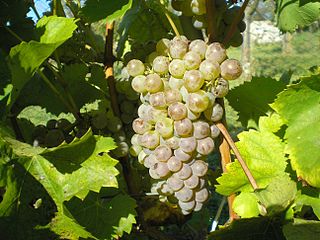 W
WMalverina is a grape variety used for making white wine. It was created in former Czechoslovakia by a group called Vine Research Centre Resistant. Malverina is a result of an inter-specific breeding "Rakish" × "Merlan". It exhibits high resistance against both powdery and downy mildew, thus it is suitable for producing wines in limited-spray vineyards. Grapes ripen in mid-October. It is grown in Moravia. High quality wines aged in bottles are full-bodied with distinctive cinnamon aroma and with long persistence.
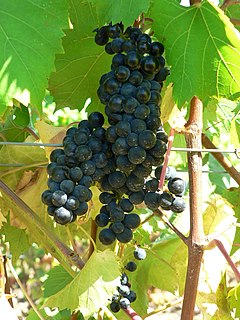 W
WMaréchal Foch is an inter-specific hybrid French red wine grape variety. It was developed at the Oberlin Institute in Colmar-Alsace, at the beginning of the 20th century, by Eugène Kuhlmann, then known as Kuhlmann 188-2. The variety arrived in the U.S. in 1946, where it was subsequently renamed Marechal Foch in honor of Marshall Ferdinand Foch, Supreme Allied Commander during the First World War. Some believe it to be a cross of Goldriesling with a Vitis riparia - Vitis rupestris cross. Others contend that its pedigree is uncertain and may contain the grape variety Oberlin 595. It ripens early, and it is cold-hardy and resistant to fungal diseases. The berry size is small, which makes it prone to bird injury. The quality of wine produced by Marechal Foch vines is highly dependent upon vine age, and the flavor profile associated with many new-world hybrid varietals is much reduced in examples made with fruit picked from older vines.
 W
WMarquette is an inter-species hybrid red wine grape variety. It was developed at the University of Minnesota as part of its grape breeding program, and is a cross between two other hybrids, MN 1094 and Ravat 262. Marquette was introduced in 2006 and has good resistance to downy mildew, powdery mildew, and black rot, as well as being cold hardy.
 W
WMassasoit is one of the collection of hybrid grape varieties known as Rogers' Hybrids, created by E.S. Rogers in the mid-19th century, and is the result of a cross of Carter, a selection of Vitis labrusca, and Black Hamburg, a selection of Vitis vinifera. It was originally known as Rogers No. 3, but 1869 Rogers named it after a prominent Native American chief from early Massachusetts history, Ousamequin, who used the title Massasoit.
 W
WMerzling is a white grape variety used for wine. It was bred in 1960 by Johannes Zimmermann at the viticultural institute in Freiburg, Germany by crossing Seyve-Villard 5276 with the cross Riesling × Pinot gris.
 W
WMuscat bleu is a red Swiss wine and table grape variety that is a hybrid of Garnier 15-6 and Perle noire. The grape was developed in Peissy in the Canton of Geneva by Swiss grape breeder Charles Garnier in the 1930s. Today the grape is used as both a table grape and for winemaking, producing wines that Master of Wine Jancis Robinson describe as "soft and grapey". Outside Switzerland some plantings of Muscat bleu can also be found in Belgium.
 W
WNiagara grapes are a variety of the North American grape species Vitis labrusca and are used as table grapes and for wines, as well as jams and juice. Niagara is the leading green grape grown in the United States. A purple variety, known as "pink" niagara, exists and is the main niagara cultivated in southern Brazil, principally in the states of São Paulo, where the variety first occurred in 1933, and Rio Grande do Sul. The Niagara grape was created in Niagara County, New York, in 1868 when Claudius L. Hoag and Benjamin W. Clark cross-bred Concord grapes with white Cassady grapes. It was first sold commercially in 1882. Niagara grapes are considered to be poor shipping grapes, and so are usually only found near where they are grown. They are most commonly found in the United States in New York, Pennsylvania, New Jersey, Michigan, Washington, and Ohio, and are also grown in Ontario in Canada, as well as in Brazil, and New Zealand. While only rarely available fresh outside these areas, Niagara grapes are well known to most American consumers as the source of most white grape juice.
 W
WNorton, a grape cultivar believed to be largely derived from Vitis aestivalis, is grown in the Midwestern United States, Mid-Atlantic States, northeastern Georgia, and, most recently, in California. Norton was first cultivated in Richmond, Virginia, and is the official grape of the State of Missouri and is considered the cornerstone of the Missouri wine industry. Strong evidence indicates that Dr. Daniel Norton first purveyed the Norton cultivar during the early 19th century from his vineyards in Virginia, USA. Further evidence has been reported that Dr. Norton developed the cultivar from seeds from a now extinct variety with unconfirmed parentage, Bland, pollinated by a Vitis Aestivalis grapevine. In 2009, Riedel designed stemware specifically for wine made from the Norton grape. The glass was unveiled at Les Bourgeois Winery near Columbia, Missouri.
 W
WOlmo grapes are wine and table grape varieties produced by University of California, Davis viticulturist Dr. Harold Olmo. Over the course of his nearly 50-year career, Dr. Olmo bred a wide variety of both grapes by means of both crossing varieties from the same species or creating hybrid grapes from cultivars of different Vitis species.
 W
WRegent is a dark-skinned inter-specific hybrid grape variety, used for making wine. It has both European and American vine species in its pedigree and a broad resistance against the most significant fungal diseases which affect grapes, such as downy mildew.
 W
WRondo is a dark-skinned grape variety, used for making red wine. It is a hybrid grape or inter-specific crossing. It was created in 1964 by Professor Vilém Kraus in then-Czechoslovakia by crossing the varieties Zarya Severa and St. Laurent. He offered it to Dr. Helmut Becker (1927-1990) of the Geisenheim Grape Breeding Institute who conducted further work on it, which explains why the grape is known under a Geisenheim designation. The variety was first planted for research and later in bigger scale in the mid 1980s by Thomas Walk Vineyard in Ireland under the name Amurensis Walk; it was named Rondo in 1997.
 W
WSeyval blanc is a hybrid wine grape variety used to make white wines. Its vines ripen early, are productive and are suited to fairly cool climates. Seyval blanc is grown mainly in England, the United States east coast, in the Pacific Northwest (Oregon), as well as to a lesser extent in Canada. Seyval blanc was created either by Bertille Seyve, or his son-in-law Villard, as a cross of Seibel 5656 and Rayon d'Or, and was used to create the hybrid grape St. Pepin. Seyve and Villard used the same Rayon d'Or x Seibel 5656 crossing to produce the red wine grape Seyval noir.
 W
WSolaris is a variety of grape used for white wine. It was created in 1975 at the grape breeding institute in Freiburg, Germany by Norbert Becker.
 W
WThomcord is a seedless table grape variety and a hybrid of the popular Thompson Seedless or Sultanina grape and Concord grape. Thomcord was developed in 1983 by Californian grape breeders working for the Agricultural Research Service (ARS), an agency of the United States Department of Agriculture (USDA), as part of a test to better understand a new seedless grape breeding procedure.
 W
WTraminette is a cross of the French American hybrid Joannes Seyve 23.416 and the German Vitis vinifera cultivar Gewürztraminer made by Herb C. Barrett ca. 1965 at the University of Illinois, Urbana/Champaign. His intention was to produce a large clustered table grape with the flavor of Gewürztraminer. He sent the cross to the New York State Agricultural Experiment Station grape breeding program at Cornell for development when he departed from Illinois. Traminette was found to have excellent wine quality, combined with good productivity, partial resistance to several fungal diseases, and cold hardiness superior to its acclaimed parent, Gewürztraminer, while retaining a similar character.
 W
WTriomphe d'Alsace is a black grape variety of Franco-German origin, commonly grown in the United Kingdom.
 W
WVidal blanc is a white hybrid grape variety produced from the Vitis vinifera variety Ugni blanc and another hybrid variety, Rayon d'Or. It is a very winter-hardy variety that manages to produce high sugar levels in cold climates with moderate to high acidity.
 W
WVignoles is a complex hybrid wine grape variety that was developed by J.F. Ravat originally named Ravat 51. According to Ravat, "Ravat 51" was the result of a cross made in 1930 using the complex hybrid wine grape Seibel 6905 and a clone of Pinot Noir known as Pinot de corton. Originally named "Vignoles" by the Finger Lakes Wine Growers Association in 1970, genetic testing has recently proved that Vignoles does not share any major genetic markers in common with Seibel 6905 or Pinot Noir. Thus, Vignoles is unrelated to the "Ravat 51" grapevine that was imported into the US in 1949 and the parentage of Vignoles is currently unknown.